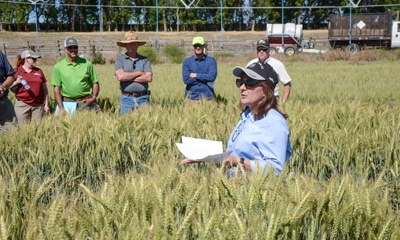
Winter wheat growers on the Plains have dealt with their share of diseases in recent years. Long, mild falls followed by cool, wet springs have provided a perfect storm for diseases like barley yellow dwarf virus, which has been occurring more frequently in wheat-growing regions of the U.S., notes Juliet Marshall, University of Idaho associate professor of cereals agronomy and pathology.
"With barley yellow dwarf, we've seen higher than a 50% yield reduction in some cases in Idaho," Marshall says. "We see a lot of test weight reduction, a lot of yield reduction from barley yellow dwarf."

MANAGE THE GREEN BRIDGE: At a field day in June, the University of Idaho's Juliet Marshall explains that barley yellow dwarf virus, which is vectored by aphids, can be controlled by managing the "green bridge." "In the last several years with warm, long falls, aphids have had a lot of opportunity to fly from infected corn to newly planted winter wheat or winter barley without that freeze to kill them," she says.
At a field day near Buhl, Idaho, in June, Marshall discussed options for barley yellow dwarf control —including delayed planting and insecticidal seed treatments. In September, University of Idaho scientists Arash Rashed (entomology) and Juliet Marshall began research trials to evaluate how effective insecticidal seed treatments are in preventing the spread of barley yellow dwarf virus (BYDV) in winter wheat.
The virus is only vectored by several kinds of aphids — most notably English grain aphids and bird cherry-oat aphids. Because aphid populations are significantly reduced by freezing temperatures, they're not a problem for spring wheat, which is planted early spring in colder temperatures before aphid populations rebuild. But aphids do pose a threat to winter wheat and winter barley.
"The aphids are building all season long on wheat, but also corn. The issue with planting winter wheat too early comes with the 'green bridge' overlap," Marshall says. "In the last several years with warm, long falls, aphids have had a lot of opportunity to fly from infected corn to newly planted winter wheat or winter barley without that freeze to kill them."
The trial includes 10 treatments with different insecticidal seed treatments planted Sept. 21, 2015, and a controlled treatment with no insecticidal seed treatment planted on the same date. All 11 treatments are on the same soft white winter wheat variety. In a separate trial, however, U of I researchers are working to identify varieties that are resistant to BYDV so breeders can integrate them into their breeding programs.
"Fourteen days after emerging, the untreated control with no insecticidal seed treatment had 10 aphids per plant. If the seeding rate is 1 million seeds per acre, that's over 10 million aphids per acre. That's a lot of aphids," Marshall says. "Trials with insecticidal seed treatments reduced aphids from 10 to one to four aphids per plant. But even one aphid per plant can still transmit the virus, so it's not going to be an easy answer. Twenty-one days after emergence, insecticide-seed-treated plants saw no significant reduction in aphid numbers over control."
Symptom expression was scored visually, and samples from each plot were tested using enzyme-linked immunosorbent assay (ELISA) tests. Every plot in the field had some level of BYVD — no plots were clean.
The earlier the infection, the more severe the impact, and Marshall notes insecticidal seed treatments provide an option to reduce the severity of the field infection by killing aphids before they can transmit it throughout the field. The challenge is that aphids have to feed on the plant in order to consume enough insecticide to kill them, and by feeding, they transmit the virus — and it's hard to keep the virus from spreading throughout the field when there are 10 million aphids per acre.
That's why Marshall says it takes a combination of management practices producers have at their disposal to combat BYDV, including eliminating the "green bridge" by delaying planting.
"By planting late, you're reducing maximum yield, and we're essentially asking growers to do that to protect against BYDV infection," she says. "If you need to plant earlier, think about what insecticidal seed treatments are going to protect your crop — maybe even adding a foliar insecticide application two to three weeks after emergence. It's going to take a combination of management practices to control aphids."
About the Author(s)
You May Also Like






